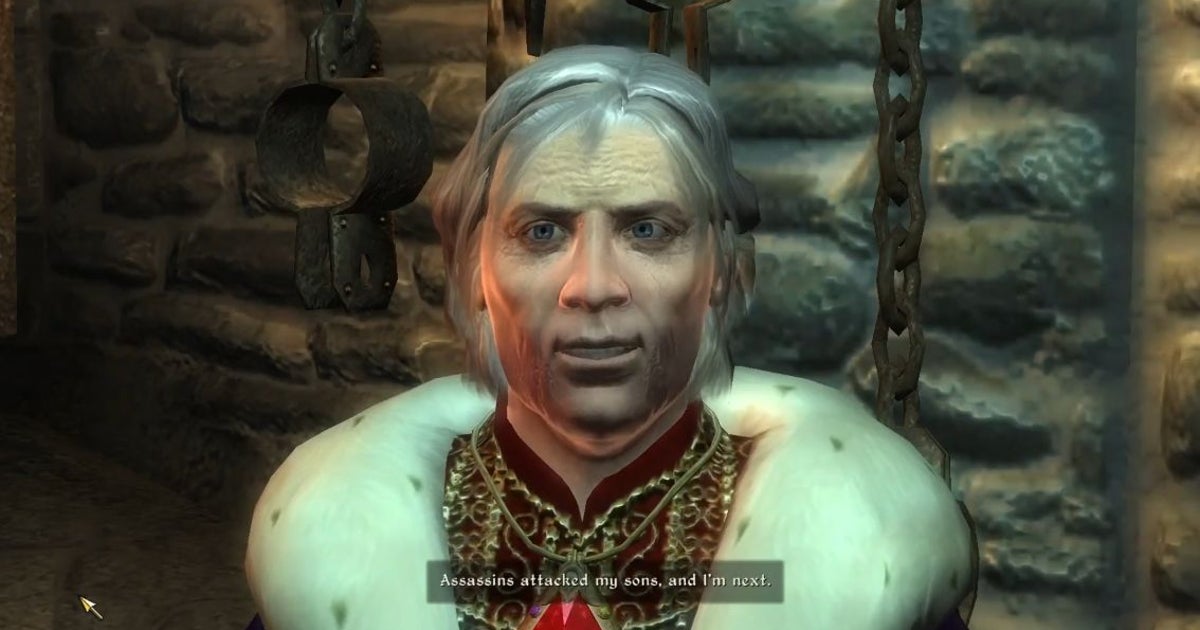The Emperor Uriel Septim VII is looking at me with a confidence I haven’t earned in the ten minutes since he busted me out of his own prison.
His uncomfortably fervent eye contact is only amplified by the crash-zoom Bethesda employs to bring us into conversation – pulling my own face from halfway across the city sewer to within a few inches of his. “Close shut the jaws of Oblivion,” he intones in the voice of Patrick Stewart. He’s still staring when, a few moments later, he’s struck down by an assassin.
Uriel’s final words ring in my ears the next time I visit the Imperial City – not for their great portent, but for the irony. After a few days of haphazard adventuring in the surrounding countryside, I’ve been arrested. The night before, I’d spotted a row of wine bottles in a roadside inn and couldn’t resist sweeping them off the shelf and down the stairs. The act was witnessed by the local black market dealer who, presumably grateful for the distraction from his own activities, flagged down a passing soldier. Now I’m waking up back where I started, as the guards close shut the jaws of jail.
This is The Elder Scrolls IV: Oblivion, a chosen-one story that gives you an unusual amount of latitude to choose what happens along the way. A grand and absurd simulatory playground that defined RPGs for a generation.
If you belong to one of the generations that came along in the two decades since, you might wonder why it meant so much to so many. What once was slick now looks clunky. Oblivion’s first-person combat comes without a parry button, and a dodge-roll unlocked so late that many never knew it existed. Nostalgists talk fondly of sneaking into merchants’ stores after dark to rinse their display cabinets, yet Oblivion’s stealth systems are so basic and binary that NPCs don’t even have a searching state – trailing behind the artificial intelligence of Thief: The Dark Project, released almost eight years prior. Then there’s the no-frills dialogue, delivered by a pool of voice actors so small they could scarcely populate a village without doubling up, let alone a country.
But more than any other game, Oblivion ushered in the multi-platform era that has shaped our medium ever since. After the freak success of a Morrowind port on the original Xbox, and facing the new power of the 360 and PS3, Bethesda found itself uniquely placed to fuse the two worlds of PC and console. The latter had, until that point, been largely dominated by Japanese role-playing games – but Oblivion was fuelled by a computer RPG design philosophy that valued player agency and freedom of exploration over tightly-plotted shenanigans with gods. It was an approach that suited the expanding draw distances of the nascent open-world genre, and captured the imaginations of the mainstream – even as Bethesda handed them a mortar and pestle and asked them to smash flowers together.
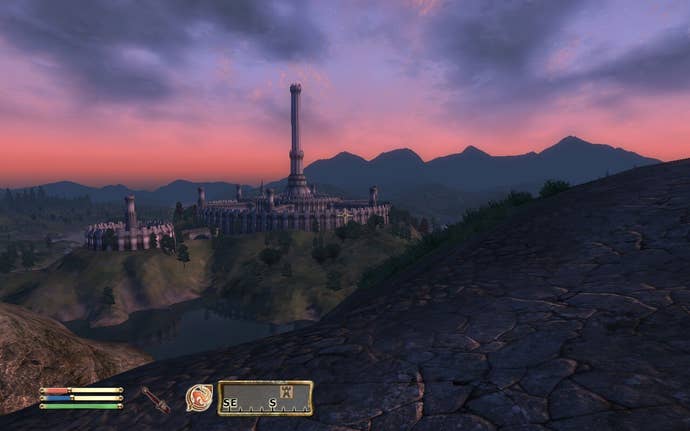
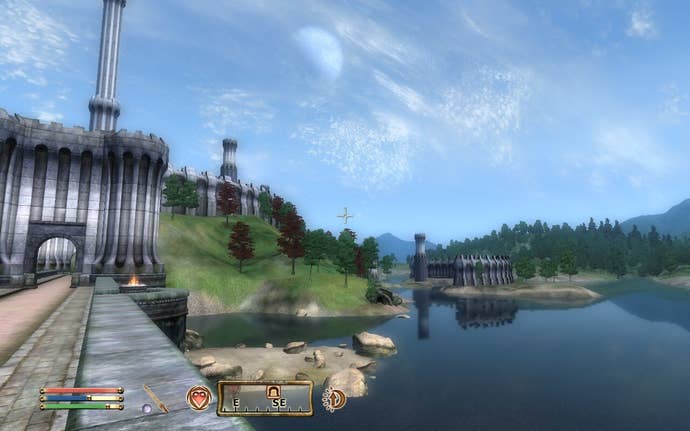
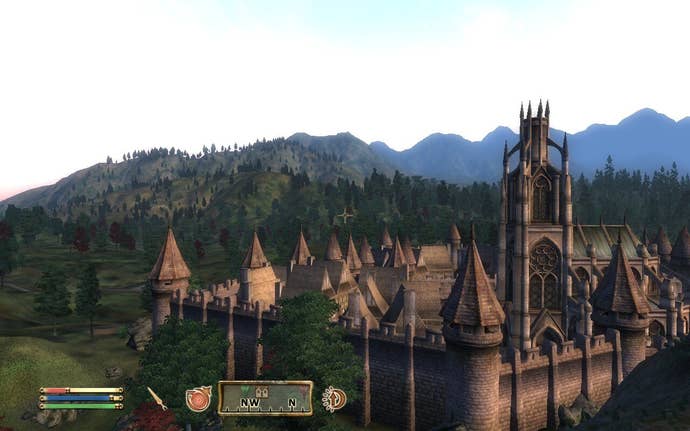
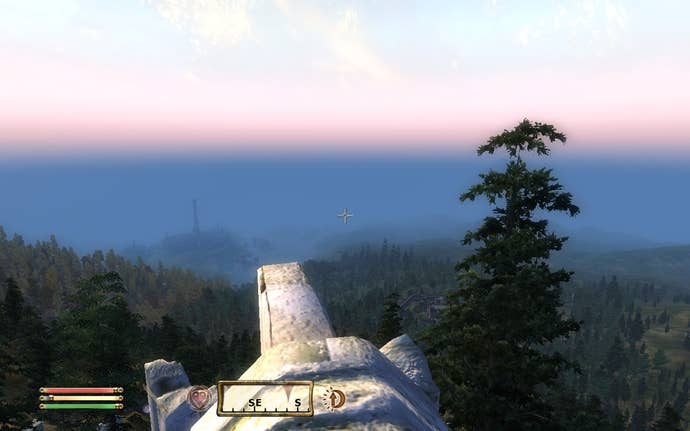
Oblivion’s dev team were willing alchemists themselves, investing in graphical heft and full voice acting without sacrificing too much in the way of simulation – even incorporating the idea of a living world into their marketing pitch. Being a western RPG fan in the early noughties had meant accepting certain tradeoffs, but Oblivion promised we could have it all: the immediacy of first-person shooters, and the flexibility to pick our own path that had previously been associated with desktop and tabletop role-playing.
All of this was wrapped in a fantasy readily digestible by the masses – still grudgingly coming to terms with nerd culture’s hold on the entertainment industry. There’s no understanding Oblivion without talking about Tolkien. Peter Jackson’s Lord of the Rings trilogy was fresh in the public imagination, and the setting of Cyrodiil was exactly the right shade of green and temperate land to evoke Rohan and the Shire. The signature Ayleid ruins that dotted Oblivion’s fields and forests, gleaming like bone, bore a striking resemblance to the ivory arches of Minas Tirith – while the turquoise-tinted glow of the dungeons below resembled the Doors of Durin that guarded the way to Khazad-dûm.
What’s more, the enemies of Oblivion were skeletons, demons and goblins – unapologetic high fantasy archetypes which stood in contrast to the ash creatures and cliff racers of oddball Morrowind. Some RPG veterans may have balked at the old tropes, but Bethesda embraced the challenge of making the familiar new through sheer fidelity and first-person immersion. If Oblivion was vanilla, it was to be made with the finest Madagascan pods and taste better than ever.
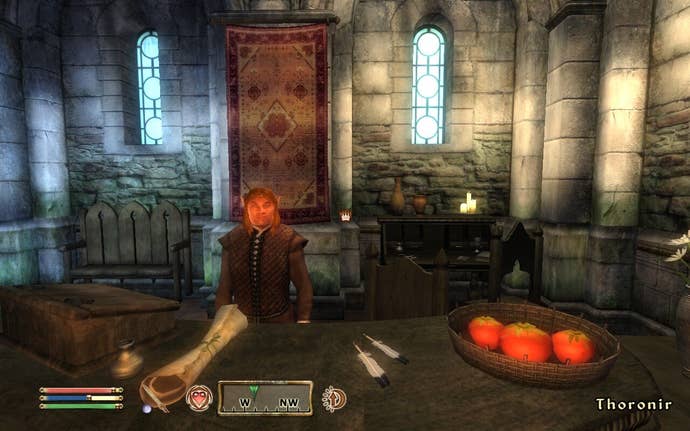
Today, with nearly 20 years of checklist-chasing open worlds in the rear-view mirror, Oblivion no longer seems as safe and crowd-pleasing as it once did. It is a catalogue of extraordinary quirks, belonging as much in conversation with Dragon’s Dogma 2 as with The Witcher 3. This is a game in which you can be shot with an arrow and find yourself suddenly overencumbered, until you pluck the offending missile out of your inventory or fire it back. In which you quite literally learn from your mistakes – gaining experience in armour when a wolf tears past your shield and rips at the leather on your chest, and in acrobatics when you trip off a cliff and survive the fall.
Oblivion’s dungeons are a celebration of physics and its wibbly-wobbly possibilities. Spot a tripwire before you stumble into it, and you’ve gained a trap of your own – one you can set off by slicing the thread with your own weapon, sending a cartload of logs barrelling into the necromancer you’ve tempted over from the next room. Those Ayleid ruins, meanwhile, are riddled with precious stones placed high out of your reach. Figuring out the trickshots to knock them from their perch will make you rich.
The stones can also be used to absorb mana – useful if you’ve picked the marvellously counterintuitive Atronach birthsign, which leaves you unable to regenerate magic naturally. Atronachs must take their power from other sources – leaping into the trajectory of enemy fireballs to bask in their borrowed energy. They’re not so far away from Fallout 76’s newly playable ghouls, who bathe in the same radiation that kills their peers.
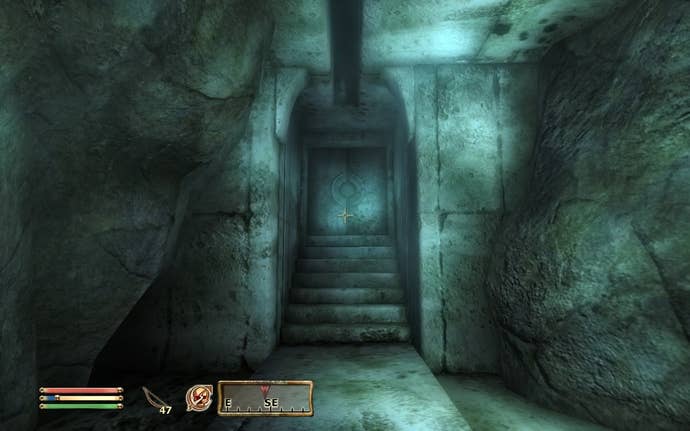
Combat in Cyrodiil is more tactical than you might remember: an exercise in reprogramming your opponents through the use of poisons. Catch a distant wizard with an arrowhead dipped in intelligence-draining potion and they’ll be reduced to waving daggers around; seep a fatiguing venom into the blood of a goblin and you can watch as the stat change takes effect – slowing the frenetic swing of their arms just enough for you to start returning blows during the interludes.
There’s something about Oblivion’s tone, too, when played in 2025 – strikingly earnest and disarmingly uncynical. When you first level up, you’re met with the realisation that, “all your life, you have been coasting along as if you were in a dream. Suddenly, facing the trials of the last few days, you have come alive.”
The wide-eyed wonder starts to fade, of course, and that’s when Oblivion is at its weakest – as you begin to feel the imperfect level-scaling at work among your enemies, and start to see the pattern to the dungeons. The latter wouldn’t become more varied until Bethesda made a concerted effort to reduce identikit room designs in Fallout 3 – which leaves Oblivion gates in particular feeling like a chore. I’ll close shut those jaws in a bit, Uriel, I swear. After I’ve unloaded the dishwasher.
Some of these mid-game flaws will surely be addressed by the upcoming remaster; some likely cannot. Nevertheless, the messy magic of Oblivion remains. There comes a moment when, high in the hills of County Chorrol and newly infected with a Latin-sounding disease I worry might progress into vampirism, I turn back and spy the White-Gold Imperial tower on the horizon. And consider that, in all the days of walking and riding since leaving those sewers, I’ve never once been bored.
